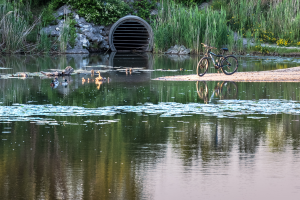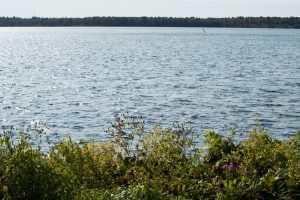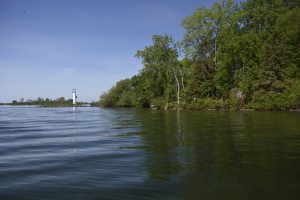by Chantal Lefevre, Natural Edge Regional Coordinator
Green infrastructure, which encompasses a range of natural and semi-natural designed features, provides ecological, economic, and social benefits. It has gained increasing attention in recent years as a key strategy for achieving sustainable and climate change resilient environments.
In Canada, where natural resources are abundant, green infrastructure has the potential to create significant economic value through various mechanisms, including ecosystem services, property value enhancement, and job creation. Municipalities across Canada are taking advantage and creating inventories of green infrastructure in their area. For example, Ontario Regulation 588/17: Asset Management Planning for Municipal Infrastructure, a provincial policy that requires municipalities to produce Strategic Asset Management Plans accounting for all municipal assets, including green infrastructure assets (Government of Ontario, 2017). The regulation strives to standardize municipal asset planning while ensuring decision-makers consider the strategic benefits and drawbacks of assets, including natural and designed green infrastructure.
Ecosystem services, which refer to the benefits that people derive from natural ecosystems, are a major source of economic value provided by green infrastructure. Examples of ecosystem services include: filtering air and water, regulating climate, increasing soil fertility, and stewarding biodiversity conservation (Costanza et al., 1998). Infrastructure can include:
- parks, green roofs, stormwater ponds, street trees, and gardens in urban areas;
- wetlands, forests, conservation areas, lakes and rivers in rural areas; and
- non-natural assets such as renewable energy, rainwater harvesting.

A stormwater pond is an example of green infrastructure.
These varieties of green infrastructure can help mitigate air and water pollution, reduce stormwater runoff and flood damages, and provide recreational opportunities, among other benefits. According to a study by the David Suzuki Foundation, the value of the ecosystem services provided by the Ontario Greenbelt’s natural capital area is significant. This area conserves agricultural and natural landscapes in southern Ontario. The annual value of the region’s measurable non-market ecosystem services are an estimated $2.6 billion annually; an average value of $3,487 per hectare (David Suzuki Foundation, 2008).
The Ontario Greenbelt’s wetlands and forests hold the greatest value, worth over $2.3 billion. Wetlands are worth an estimated $1.3 billion per year ($14,153/hectare) because of their high value for water regulation, water filtration, flood control, waste treatment, recreation, and wildlife habitat (David Suzuki Foundation, 2008). Forests provide key services worth $989 million each year because of their importance for water filtration services, carbon storage services, habitat for pollinators, wildlife, and recreation.
New green infrastructure technologies such as soil cells (e.g., silva cells) can improve the value of street trees and other green infrastructure. This innovation supports the maintenance of urban trees. Soil cells improve stormwater management by directing stormwater into underground chambers filled with media (the material in which plants grow) that support urban trees (Urban & Marritz, 2019). Part of the captured water is absorbed by trees, which are free to grow and spread their roots. The remainder of the water continues into the city’s drainage systems. The soil cells can enhance urban tree growth, tree lifespan, and existing tree benefits (e.g., shade, rainfall interception, stormwater infiltration, evapotranspiration) without being limited by or damaging grey infrastructure such as sidewalks (Urban & Marritz, 2019).

Green infrastructure, like vegetated shoreline buffers, can mitigate air and water pollution, reduce stormwater runoff and flood damages, and provide recreational opportunities.
Another example of green infrastructure improvement of rivers or lakes is the implementation of riparian buffers. Riparian buffers, or the natural edge “ribbon of life”, are areas of vegetation along the banks of water bodies that protect water quality and provide a range of ecological benefits. The vegetation within the buffer zone can absorb nutrients and pollutants from runoff and can improve the water quality by filtering out sediments and other contaminants (Stutter et al., 2019). The buffer also provides habitat for a variety of species, including fish, birds, and mammals, and helps maintain biodiversity in the surrounding ecosystem. It is estimated that 70% of all terrestrial life utilizes riparian zones at some point in their lifecycle (Gregory et al., 1991). Additionally, riparian buffers can help reduce the impacts of erosion, reduce and protect against flooding, and improve the resilience of the ecosystem to climate change impacts such as droughts and extreme weather events (Stutter et al., 2019).
Waterways and riparian buffers provide a range of economic benefits, but it can be difficult to estimate their overall value due to the complexity of the ecosystem services they provide. However, some studies have attempted to quantify the economic value of these services.
For example, The World Resources Institute estimates Wetlands and shorelands ecosystems across the world provides services up to $15 trillion, including flood protection, fisheries habitat, and water purification (World Resources Institute, 2009). Another study by Rein, F.A revealed that a cost of $23–$727/hectare/year is avoided by municipalities and landowners maintaining a riparian buffer along the Elkhorn Slough river in Monterey Bay, California, USA (Rein, 1999). Green infrastructure can save municipalities and taxpayers money by providing benefits that would otherwise have to be paid for by building and maintaining grey infrastructure (traditional built stormwater infrastructure).
In addition to these benefits, healthy water bodies and riparian buffers can also provide economic benefits through industries such as fishing, agriculture, and tourism. The recreational fishing industry in Canada generates billions of dollars in revenue annually, much of which is dependent on healthy river and lake ecosystems. Similarly, riparian buffers can protect farmland from erosion and improve soil fertility by keeping the nutrients on the land and not in the water, leading to increased agricultural yields and decreased risk of eutrophication (Elmqvist, 2015).
Overall, the economic value of waterbodies and riparian buffers is significant and can provide a range of benefits to society. However, the exact value will depend on the specific context and the services provided by the particular waterbody and riparian ecosystems. Countries are realizing these benefits and are investing in green infrastructure. For example, New Zealand has a $1.1 billion program that aims to create 11,000 jobs through major investments in restoring wetlands and riverbanks, removing invasive species, and improving tourism and recreation services on public lands (World Resources Institute, 2009).
Another great example of municipalities using green infrastructure is New York City, USA. New requirements in the 1990’s mandated drinking water be filtered and meet certain requirements. City managers determined that a new filtration system would cost US$6 to $8 billion to build and another US$300 million annually to operate (Chichilnisky & Heal, 1998). The alternative approach would include a watershed protection program including land purchase for conservation, pollution reduction, and conservation easements that would allow the natural ecosystems to purify the water. This would cost between US$1 billion and US$1.5 billion. New York City chose to invest in the natural ecosystem services of the watershed rather than building new grey infrastructure, based on calculations which determined that protecting the watershed had a better rate of return (90 to 170 per cent) and a shorter payback period of four to seven years (Chichilnisky & Heal, 1998). The complex network is the largest unfiltered surface water supply in the world, supplying 1.3 billion gallons of water each day.
Another way in which green infrastructure creates economic value is by enhancing property values. Research has shown that proximity to parks and green spaces can increase the value of residential and commercial properties. For instance, a University of British Columbia (UBC) research report, “Corridors of Green and Gold: Impact of riparian suburban greenways on property values”, attributes a 10-15% increase in property value for homes that are in close proximity to a greenway in urban areas (Hamilton & Quayle, 1999).

Green infrastructure also creates economic value is by enhancing property values. (Photo: Stephany Hildebrand)
Several studies examining house sale prices estimated the impact of water clarity changes on lakefront property values. Studies in Maine and New Hampshire, USA have estimated for every one metre change in water clarity depth, property values increased, ranging from $1,100 to $12,938 per lakefront property (Gibbs et al,. 2002). These findings highlight economic benefits of municipalities and individuals investing in green infrastructure.
Green infrastructure also has the potential to create jobs and stimulate local economies. Green infrastructure projects, such as wetland restoration, tree planting, and green roof installation, require a range of workers like ecologists, engineers, landscapers, and labourers. In 2018, it is estimated that Ontario’s green infrastructure sector was responsible for generating $8.6 billion in revenues and $4.63 billion in direct gross domestic product (GDP), directly employing approximately 84,400 people (Green Infrastructure Ontario Coalition, 2018). Factoring in the indirect and induced impacts, Ontario’s green infrastructure sector was responsible for more than 122,000 jobs and nearly $8.33 billion in GDP in 2018, according to a report produced for the Green Infrastructure Ontario Coalition (GIO) and the Greenbelt Foundation.
In conclusion, green infrastructure has enormous economic potential in Canada, not only through the provision of ecosystem services, but also through property value enhancement and job creation. By investing in green infrastructure, Canadian cities and communities can not only create more livable and resilient environments but also stimulate economic growth and development.
References
Chichilnisky, G., & Heal, G. (1998). Economic returns from the biosphere. Nature (London), 391(6668), 629–630.
Costanza, R., d’Arge, R., de Groot, R., Farber, S., Grasso, M., Hannon, B., Limburg, K., Naeem, S., O’Neill, R. V., Paruelo, J., Raskin, R. G., Sutton, P., & van den Belt, M. (1998). The value of the world’s ecosystem services and natural capital. Ecological Economics, 25(1), 3–15.
David Suzuki Foundation. (2008). Ontario’s Wealth, Canada’s Future: Appreciating the Value of the Greenbelt’s Ecosystem Services.
Elmqvist, T., Setälä, H., Handel, S., van der Ploeg, S., Aronson, J., Blignaut, J., Gómez-Baggethun, E., Nowak, D., Kronenberg, J., & de Groot, R. (2015). Benefits of restoring ecosystem services in urban areas. Current Opinion in Environmental Sustainability, 14, 101–108.
Gibbs, J. P., Halstead, J. M., Boyle, K. J., & Huang, J.-C. (2002). An Hedonic Analysis of the Effects of Lake Water Clarity on New Hampshire Lakefront Properties. Agricultural and Resource Economics Review, 31(1), 39–46.
Government of Ontario. (2017). O. Reg. 588/17: Asset Management Planning for Municipal Infrastructure.
Grabosky, J., & Bassuk, N. (1995). A New Urban Tree Soil to Safely Increase Rooting Volumes Under Sidewalks. Arboriculture & Urban Forestry, 21(4), 187–201.
Green Infrastructure Ontario Coalition. (2018). An Economic Impact Assessment of the Green Infrastructure Sector in Ontario.
Gregory, S. V., Swanson, F. J., McKee, W. A., & Cummins, K. W. (1991). An Ecosystem Perspective of Riparian Zones. Bioscience, 41(8), 540–551.
Hamilton, S., & Quayle, M. (1999). Corridors of green: Impact of Riparian suburban greenways on property values. Journal of Business Administration and Policy Analysis, 27–29, 365-.
Rein, F. A. (1999). An Economic Analysis of Vegetative Buffer Strip Implementation. Case Study: Elkhorn Slough, Monterey Bay, California. Coastal Management, 27(4), 377–390.
Stutter, M., Kronvang, B., Ó hUallacháin, D., & Rozemeijer, J. (2019). Current Insights into the Effectiveness of Riparian Management, Attainment of Multiple Benefits, and Potential Technical Enhancements. Journal of Environmental Quality, 48(2), 236–247.
Urban, J., & Marritz, L. (2019). Growth Rates and Performance of Trees in Silva Cells.
World Resources Institute. (2009). Ecosystem Services: A Guide for Decision-Makers.
This blog post is part of a series generously funding by the Government of Canada’s EcoAction Community Funding Program, and a project delivered in partnership with Crowe Valley Conservation Authority.

This is really great information. Is there a full report or just this brief please?